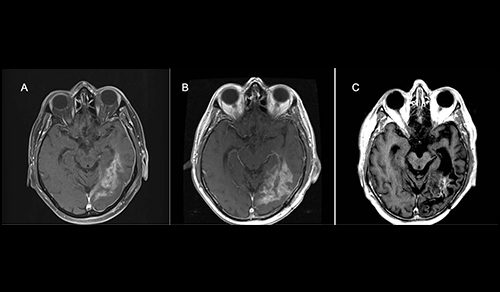How Melanoma Prepares Lymph Nodes for Metastases
Melanoma cells release small extracellular packages containing the protein nerve growth factor receptor (NGFR), which primes nearby lymph nodes for tumor metastases, according to a new study by Weill Cornell Medicine investigators. Results of the study, published in the December 2021 issue of Nature Cancer, may one day help doctors determine which patients need more aggressive treatment and could help with the development of new therapies, says senior author, David C. Lyden, PhD, MD, Professor of Cell and Developmental Biology at Weill Cornell Medicine and a member of the Weill Cornell Medicine Meyer Cancer Center.
Dr. David C. Lyden
Traditionally, scientists have had a tumor-centric view of melanoma in which cells from the tumor break off and travel to nearby lymph nodes as cancer metastasizes. “What our study shows is that the lymph node functionally prepares for future metastases,” says Dr. Lyden, a pediatric hematologist-oncologist at NewYork-Presbyterian/Weill Cornell Medical Center. “There are many changes taking place in the lymph node even before the tumor cell gets there. We call it a pre-metastatic lymph node.”
The initial research began in Dr. Lyden’s lab, where he and postdoctoral associates at that time, Héctor Peinado, PhD, and Alberto Benito Matin, PhD, examined the release of exosomes from melanoma tumor cells in mouse models, finding that the NGFR is released in exosomes secreted by melanoma cells and carried into the lymph nodes. The protein is then taken up by lymph endothelial cells where it reprograms the lymph node to form new lymph vessels. This process, lymphangiogenesis, encourages cancer spread. “The more vessels a lymph node has, the more tumor cells can enter,” says Dr. Lyden. “Moreover, NGFR increases the secretion of the protein intracellular adhesion molecule 1, which encourages tumor cells to bind to lymph vessels, also promoting metastases.”
“Lymphatic endothelial cells are the first encounter for exosomes containing NGFR and open the gates to melanoma cells coming into the lymph node and setting up shop there,” says Irina Matei, PhD, Assistant Professor of Immunology Research in Pediatrics at Weill Cornell Medicine, and a co-author on the study.
The research team also investigated how the presence of integrins on the surface of exosomes determines where metastatic melanoma cells will spread, finding that integrin alpha is important for spread to the lymph nodes versus other organs such as the liver.
“Overall, while the lymph nodes should be sites of immune system activation and tumor rejection, the processes outlined in the study demonstrate that the cancer-fighting function of lymph nodes is compromised by melanoma-derived exosomes,” says Dr. Lyden. “This may have implications for prognosis.”
“With a diagnosis of melanoma, doctors examine a patient’s sentinel lymph node to see if it contains cancerous cells. However, the examination of the sentinel lymph node for just tumor cells is not complete,” says Dr. Lyden. “Additional information such as the presence of NGFR or lymphangiogenesis could indicate a poor prognosis for patients and likely mean they would need aggressive treatment.”
The research could potentially influence drug development. In a mouse model, the Weill Cornell Medicine investigators used a small molecule inhibitor – THX-B – to block NGFR from promoting lymphangiogenesis, helping to deter lymph node metastases. “While this drug needs a lot of testing, I think eventually an NGFR inhibitor could be used in the clinical setting,” adds Dr. Lyden.
The researchers followed up on their mouse model findings by studying lymph node tissue from 44 patients with stage III or IV melanoma and found that NGFR expression was significantly higher in metastatic lymph node tissues than in the original skin lesions. Evaluation of another 25 patients with stage III melanoma found a significant increase in the frequency of NGFR positive tumor cells in lymph node metastases compared with the originating melanoma tumor.
“Those patients with metastatic disease actually had very high NGFR expression,” explains Dr. Lyden. “So, at all stages, whether it’s pre-metastatic or full-blown lymph node metastasis, it seems that NGFR correlates with worse prognosis.”
The researchers aim to validate their findings in larger numbers of patients. “We also would like to determine if we can use a simple blood test to see whether exosomes are carrying NGFR,” notes Dr. Lyden. “This would help doctors to look at exosomal NGFR over time during therapy to see how treatments should be adjusted.”
Read More
Melanoma-derived small extracellular vesicles induce lymphangiogenesis and metastasis through an NGFR-dependent mechanism. García-Silva S, Benito-Martín A, Nogués L, Hernández-Barranco A, Mazariegos MS, Santos V, Hergueta-Redondo M, Ximénez-Embún P, Kataru RP, Lopez AA, Merino C, Sánchez-Redondo S, Graña-Castro O, Matei I, Nicolás-Avila JÁ, Torres-Ruiz R, Rodríguez-Perales S, Martínez L, Pérez-Martínez M, Mata G, Szumera-Ciećkiewicz A, Kalinowska I, Saltari A, Martínez-Gómez JM, Hogan SA, Saragovi HU, Ortega S, Garcia-Martin C, Boskovic J, Levesque MP, Rutkowski P, Hidalgo A, Muñoz J, Megías D, Mehrara BJ, Lyden D, Peinado H. Nature Cancer. 2021 Dec;2(12):1387-1405.
Related Publications






